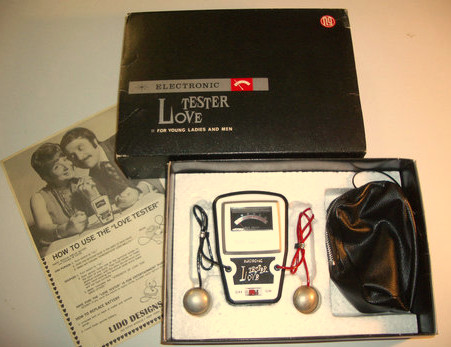The love tester or love meter was once regarded as truth. But now, it’s often seen as part of amusement parks and isn’t taken that seriously. So what happened to this once serious-seeming science?
The love tester was once believed to be scientific and factual and that its findings were accurate. People today see it as entertainment, which is rarely taken seriously. The big question is, was there ever any truth from the start? Were its findings accurate?
And what happened to the love tester that it devolved from being regarded as truth to now just an attraction?
Let’s discover how the love testers evolved and the truth behind them.

J. Frank Meyer’s Love Tester
In 1920, J. Frank Meyer had established the Exhibit Supply Company in Chicago to build the machines that sold the cards for a penny a piece. Then, when the arcades began losing their audience to movie theaters, Meyer became more inventive, dreaming up a host of new amusement machines that combined modern mechanical and electrical know-how with eternal human insecurities.
In a patent application submitted in August 1930, Meyer sketched the first penny arcade love meter — less a measure of attraction between two people than a single person’s appeal. Users would insert a penny and then grip a gleaming metal handle molded to the shape of the fingers.
The machine would then measure the user’s level of passion, from “cold” to “uncontrollable.” Several months later, Meyer would name it the Love Tester and submit a design patent application for a metal panel that read “Measure your sex appeal on this love meter.”
Versions of Meyer’s Love Tester appeared to have been manufactured even before the patent was granted in 1933. Still, into the late 1930s, the appearance of a love tester at a local arcade was a novelty.

The Cupidoscope
The Cupidoscope was invented in the fall of 1937 by engineering students Ed Keefer and John Hawley at the University of Toledo in Ohio. Keefer was the calculus club president, the engineering club vice president, and a member of the school’s exclusive all-male honor society.
Constructed in the school’s physics laboratory, the Cupidoscope was fashioned from an old radio cabinet, a motor spark coil, and an electrical resistor. To test their bond, a man and a woman would grip electrodes on either side of the Cupidoscope and move them toward one another until the woman felt a spark — not of attraction, but of electricity.
The higher her tolerance for this mild current, the more of a love signal the meter registered. A needle decorated with hearts purported to show her devotion on a scale that ranged from “No hope” to “See preacher!”
It all sounds like a slightly painful party game — but the Cupidoscope was one experiment in a decades-long quest to quantify love, from the bond between two people to one’s appeal to possible partners.

Nintendo’s Love Tester
Before it entered into video game production, Nintendo released a product known as the Love Tester in 1969, advertised as capable of determining the love between two people. To operate the device, both users grab one of the connected spherical metal sensors with one hand and hold each other’s hands with the other; the meter on the device displays their “love score” on a scale between 1 and 100
This device was developed by Gunpei Yokai, who was also in charge of designing several other Nintendo products. Yokoi even jokingly noted that if the man kissed the woman while trying the Love Tester, they would get better results.
Since the Love Tester is no longer in production by Nintendo, it is now a retro gemstone that is sometimes sold at auction for high prices.
Are love testers accurate?
The Nintendo Love Tester and similar devices claim to get accurate results, but there is little to no relation between two people’s feelings and the conductivity between them. To be more precise, the body contains sodium, potassium, chloride, and other ions that conduct electricity.
This means that although they are produced in the body, their production comes more from the body’s function than its feelings. For example, other things that affect the production of sodium ions include medications, age, drinking too much water, hormonal changes, etc.
While love testers used to be the source of truth for some people, it was already marketed as more of an attraction later on. A love tester is fun with your partner, but it shouldn’t be taken as the 100 percent basis for how much you love each other.
Conclusion
There are also many types of love you and your partner can share aside from just romance, which complicates the findings of a love tester. However, if you want to test out how conductible you are with each other, you can try a love tester to find the answer.
Follow us on Twitter, Facebook, or Pinterest

